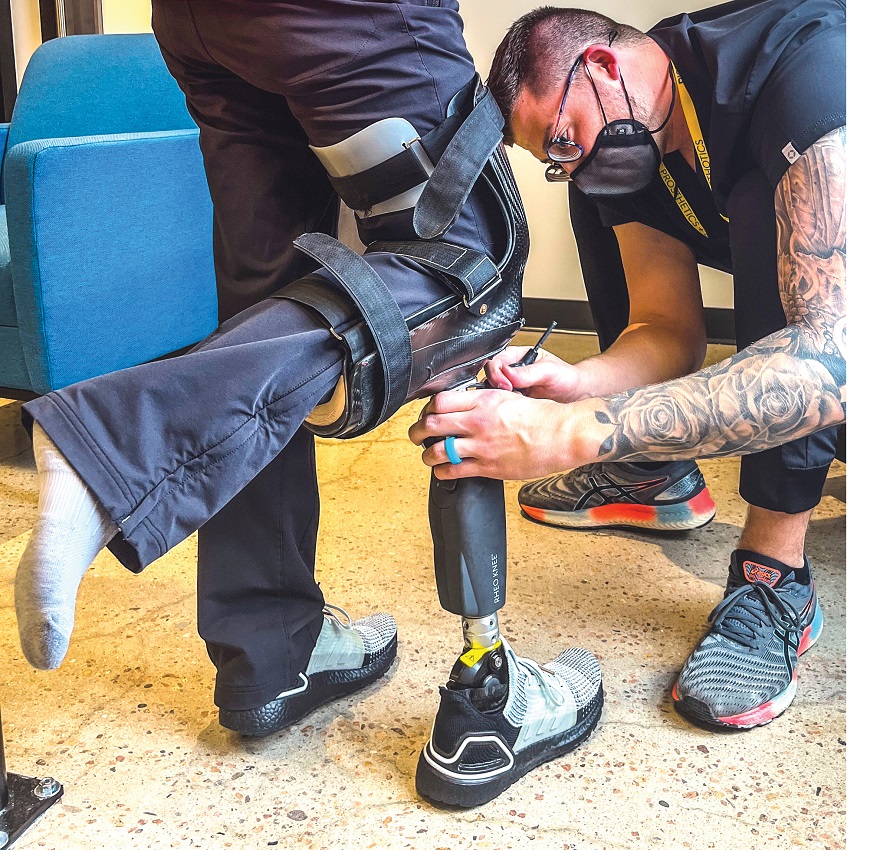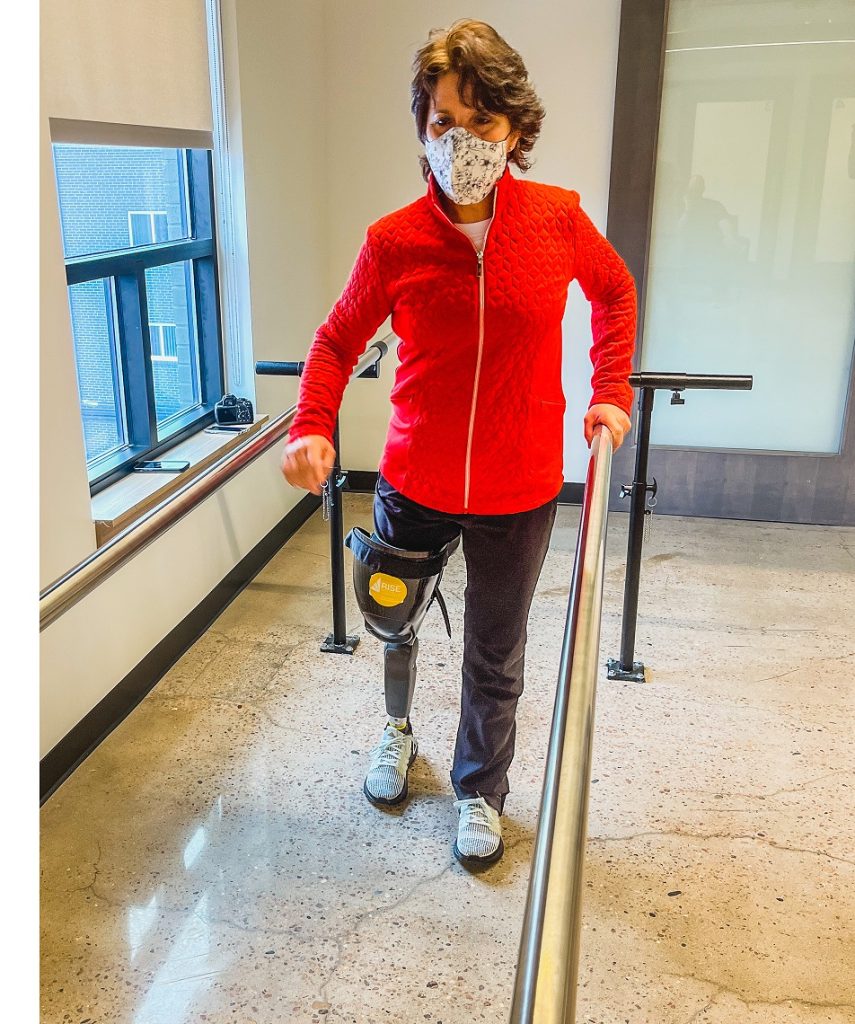I never realized how little I knew about walking until I tried doing it on a prosthesis.
By Julia Layton
Photos by Heather Swanson

Years ago, I wrote an article about ASIMO, one of the first humanoid robots. It was a prototype at the time, and part of the article examined why it’s so difficult to build a robot that walks like a human. One source described biped walking as falling and catching yourself on one leg at constantly varying speeds and from constantly varying heights. That description always stuck with me, because it didn’t sound like something I would be good at. But I’m good at walking.
It wasn’t until I tried walking with a prosthesis that I recognized how long it had taken me to get good at walking on my own two legs. A year to take my first step. A few more years of regular faceplants. I was so young that I don’t remember any of it. So as I arrived at RISE Prosthetics in Denver for a lesson in prosthetic ambulation, I wasn’t sure what to expect. I wondered if I’d be starting over from scratch.
I had gone to RISE as part of an able-bodied Amplitude delegation to meet with prosthetists Kevin Quinn and Glen Thompson for an information session about their work. My assignment was to learn how to walk with a prosthetic leg, using a bent-knee device that’s designed to be worn by a two-legged person. A bent-knee prosthesis has an opening in the back of the socket, and the wearer’s lower leg sticks out behind them while the prosthesis bears the weight. It’s most commonly used by people who are preparing for amputation surgery, to give them a preview of how it might feel to be a lower-limb amputee. But the bent-knee prosthesis has other educational purposes, too. For instance, says Quinn, surgeons sometimes try walking on it in order to get a glimpse of what their patients go through.
I had a similar goal. I hoped to gain a sliver of insight into what it’s like to move around the world on a prosthetic leg, or how it feels to apply my usual walking skills in a different body, or whether those skills would transfer at all. One of the biggest takeaways from my hour-long training with a lower-leg prosthesis is that walking might be more mental than I thought.
Starting Out on the Right Foot
I sat on a chair by the parallel bars while Thompson attached a prosthetic leg to the bent-knee socket. This leg had a mechanical knee, which uses a collection of gears and linkages to simulate the activity of the knee joint and surrounding structures. The settings in a mechanical knee are fixed, so tension doesn’t vary as you move through your gait.
Thompson asked if I’m right- or left-handed, because the prosthesis would go on my strong side, and I told him I’m a righty. Then he asked for my right shoe, which surprised me. It hadn’t occurred to me that my shoe would be going on the prosthetic foot. I instantly regretted my decision to wear high-tops (I recalled trying to drag boots onto Barbie feet), but Thompson didn’t seem fazed. He got everything laced up, held the prosthesis upright, and invited me to stand.

I grabbed one of the parallel bars, bent my right leg behind me at 90 degrees, and rested my knee in the socket. A couple of straps held my knee in place, but the socket was a bit big for me—it had been molded for someone else—so my leg moved around a bit in it. Thompson noted that the fit of an actual prosthesis needs to be extremely secure, giving the patient the utmost control over their movements. But despite the imperfect fit of the bent-knee device, Thompson assured me it gave a pretty good approximation for what it’s like to move around on a prosthetic leg.
Before I took my first step, I looked down at my temporary leg, and my first thought was: Huh. That’s my shoe down there. I hadn’t thought about what that would look like. (I clearly hadn’t thought about the foot part at all before this, which now strikes me as odd.) My high-top fully encased the prosthetic foot, so it seemed like the prosthesis ended at my ankle. I was seeing two of my own shoes but only one of my own legs. It was a strange sensation that held my attention for a while.
I hopped into place between the bars, awkwardly coaxed the prosthetic foot into what seemed like a reasonable position, and I paused for a second or two. I think I got disoriented because my own lower leg was actually bent behind me, not ready for a step at all. Thompson confirmed that this phenomenon is perfectly normal in new amputees. It felt as if my sense of my body’s position in space conflicted with what I was trying to get it to do.
I focused on the prosthetic leg and got my weight to shift forward, most of it supported on the parallel bars. The ensuing 15 minutes of practice on that mechanical knee unfolded in stages of awareness:
Stage 1. I don’t actually know what walking involves. To my surprise, I discovered that a “step” isn’t an individual act; it’s a process. And it feels a lot like what the ASIMO engineer described, a process of falling and catching myself on one leg at varying speeds and from varying heights. There was a real arc to each step, with height required to swing my foot directly under me. And there was a clear tipping point, a discrete place in the arc beyond which the mechanical knee would have to catch my weight as my body came down. But in several cases, my weight dropped behind the prosthetic leg instead of coming down squarely on top of it.
Stage 2. My mind is working against my body. That time I tried and failed at snowboarding, I struggled to let my weight tilt forward. I kept leaning uphill, which I’m told is an instinctive fear response to a steep downhill slope. It struck me that a similar fear could be causing problems here, too—my body needed to fall forward, but my mind wouldn’t allow it to. Eventually I decided to stop focusing so much on the stages of each step. On the next pass through the bars, I looked ahead at the room in front of me, instead of looking down and watching the prosthesis. I felt an immediate difference.
Stage 3. Maybe I can do this! When I fixed my gaze forward instead of down, I stopped leaning back so much. I was still wobbly, but my weight was in the right place a lot more often than it was when I was watching my shoes. The articulation felt smoother, and I started moving a little faster. Over the next few passes, I slightly loosened my grip on the bars as I walked, testing my balance. Then I gathered the courage to let go of the bars entirely for one whole step—and I didn’t fall.
Stage 4. There’s still so much to learn. Thompson applauded my progress and said he could see my confidence growing. But then he drew my attention to the gait I employed to accomplish those tentative independent steps. Without realizing it, I was listing hard to port, putting extra weight on my left (natural) leg. Thompson said he sees that type of gait in patients who are impatient to walk independently and try to skip ahead, developing habits that aren’t sustainable over the long haul. This is where back pain really comes in, he said, and I could already feel he was right.
The Knee That Knows
Thompson asked if I wanted to try a prosthesis with a microprocessor knee, so I hobbled to the chair so he could switch out the mechanical joint with a computerized one.
I had no real sense of how a microprocessor knee worked or how it would affect the process of walking. Digitization just didn’t have any meaning to me in this context. I imagined certain variables could be adjusted on the fly, but I thought this was mostly a matter of convenience or novelty value. It only took one step to see that the difference between fixed and variable settings was not just a gimmick.
This knee felt much more like my own than the mechanical one did. It felt like a force was holding the whole setup in place for me, keeping the knee stable while my weight made it to the right spot. That’s the fixed-versus-variable distinction: The microprocessor unit adjusts the resistance based on where you are in the arc of every step.
As Thompson explained, a microprocessor knee contains a set of hydraulic valves controlled by an embedded computer that receives data from gyroscopes and accelerometers to maintain safe and appropriate resistances. “The internal hardware and software of the knee are recognizing where your knee is in space, how fast it is getting there, and then taking all of that into account in real time to know when to flex/extend and how much resistance to provide when flexing/extending,” he told me. “In simple terms, the knee is trying to mimic the antagonistic relationship between your knee flexors and knee extensors [the hamstrings and quadriceps, respectively].”
The microprocessor knee was so much easier to use that I had to wonder: Why would anyone ever choose a mechanical knee over a computerized one? My guess was cost. Thompson said sometimes that’s it, but it’s more often about durability and application. A microprocessor knee would be a questionable choice in many contexts, such as scaling a climbing wall or walking in a heavy rain.
The final modification to the set-up was a hydraulic ankle. Thompson introduced it as “another point of articulation,” to which I responded, “Uh-oh.” But it turned out to make the process feel even more natural, with little adjustment from me. The bend in the ankle made it easier to pull the foot under my body, so I wasn’t swinging my leg out to the side as much. I made it through almost an entire pass without holding on to the bars. My back still felt as if I was getting ahead of myself, but I felt pretty good about my progress.
Back on My Own Two Feet
Since my short trial as a leg amputee, I’ve thought a lot about that microprocessor knee. People managed to replicate in computer code the behaviors of and interactions between anatomical structures. Perhaps this is what it feels like to be ASIMO. Or a Cylon.
But even more than the impressive technology, the humanity of prosthetics stood out to me. There is an art and an intimacy to adjusting a joint to suit the way a person moves around in the world. Quinn described carving a matching leg out of foam for an above-knee amputee, working from a photo of the patient’s healthy leg. Thompson expressed the detail and precision involved in hand-molding sockets that perfectly fit each individual’s residual limb.
He also talked about the importance of molding a relationship that fits each client’s personality. Thompson describes this art as “managing people and expectations following some of their most tragic experiences. Patients often come to us broken, defeated, and in a great deal of emotional distress. While in this state, they often have lofty goals and expectations of what they want their prosthesis to do for them.” Part of the prosthetist’s job is to help new amputees come to terms with limitations, while also recognizing opportunities. Thompson’s relationships with his patients tend to be close ones.
I’d like to say I can understand the intensity of what he’s describing. Empathy is tricky, though. You don’t know what you don’t know. But I think I came away from my trip to RISE with some new insight into what it means to walk and how it feels to inhabit a body. Focusing so intensely on a movement that I had always considered instinctive was disorienting—like when you say a simple word so many times it loses all meaning, and you have to look it up in the dictionary. Learning to walk with a prosthetic leg was like looking up “walk,” and finding out I might have been using it wrong all along.




